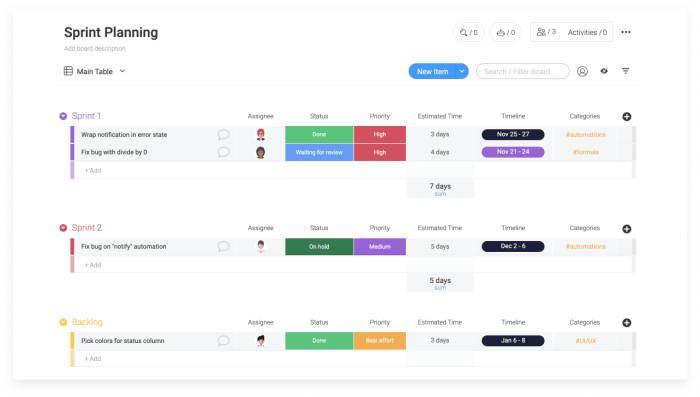How much of the sprint backlog must be defined – The sprint backlog is a crucial element in agile development, and its proper definition is essential for successful sprints. In this article, we will delve into the topic of how much of the sprint backlog should be defined, exploring its importance, benefits, and best practices.
Defining the sprint backlog at the start of the sprint is a fundamental step that sets the stage for a productive and efficient development cycle. It provides clarity on the work to be completed, reduces the risk of misunderstandings, and ensures that the team is aligned with the project’s goals.
How much of the sprint backlog should be defined at the start of the sprint?: How Much Of The Sprint Backlog Must Be Defined

Defining the sprint backlog at the start of the sprint is crucial for successful agile development. It establishes a clear understanding of the work to be completed during the sprint and helps teams prioritize and track progress. The amount of the sprint backlog that should be defined at the start depends on factors such as the team’s maturity, the complexity of the project, and the length of the sprint.
As a general rule, it is recommended to define at least 50-75% of the sprint backlog at the start of the sprint. This provides the team with a solid foundation to plan and execute the sprint. However, it is important to note that the sprint backlog is a living document that can be adjusted and refined throughout the sprint as needed.
Failing to adequately define the sprint backlog can lead to several consequences, including:
- Unclear goals and objectives
- Wasted time and effort
- Reduced productivity
- Missed deadlines
- Customer dissatisfaction
On the other hand, defining the sprint backlog in detail offers several benefits, such as:
- Improved planning and coordination
- Increased transparency and visibility
- Enhanced team collaboration
- Reduced risk of scope creep
- Increased customer satisfaction
What is the role of the product owner in defining the sprint backlog?

The product owner plays a critical role in defining the sprint backlog. They are responsible for:
- Creating and maintaining the product backlog
- Prioritizing the product backlog items
- Selecting the product backlog items for the sprint backlog
- Working with the team to define the acceptance criteria for each sprint backlog item
- Ensuring that the sprint backlog is aligned with the product vision and goals
Effective sprint backlog management by product owners involves:
- Clear communication with the team
- Regular review and refinement of the sprint backlog
- Flexibility and adaptability to changing requirements
- Collaboration with stakeholders to gather feedback
Product owners may face challenges in defining the sprint backlog, such as:
- Lack of clarity about product requirements
- Changing priorities
- Limited resources
- Stakeholder pressure
How can teams ensure that the sprint backlog is realistic and achievable?

Creating a realistic and achievable sprint backlog is essential for successful agile development. Teams can follow a step-by-step guide to achieve this:
- Break down large user stories into smaller tasks:This makes the sprint backlog more manageable and easier to track.
- Estimate the effort required for each task:This helps teams plan the sprint and allocate resources effectively.
- Prioritize the tasks based on importance and urgency:This ensures that the most critical tasks are completed first.
- Set realistic sprint goals:Teams should avoid overloading the sprint backlog with too many tasks.
- Review and refine the sprint backlog regularly:This helps teams adapt to changing requirements and ensure that the sprint backlog remains realistic and achievable.
| Effective Sprint Backlog Management Techniques | Ineffective Sprint Backlog Management Techniques |
|---|---|
| Clear and concise user stories | Vague and ambiguous user stories |
| Realistic and achievable sprint goals | Overloaded and unrealistic sprint goals |
| Regular review and refinement of the sprint backlog | Infrequent and haphazard review of the sprint backlog |
| Collaboration and communication with stakeholders | Lack of communication and stakeholder involvement |
Common pitfalls to avoid when defining the sprint backlog include:
- Overloading the sprint backlog:This can lead to missed deadlines and reduced productivity.
- Setting unrealistic sprint goals:This can demotivate the team and damage team morale.
- Failing to prioritize tasks:This can result in important tasks being overlooked or delayed.
- Lack of communication and collaboration:This can lead to misunderstandings and missed expectations.
FAQ Insights
How much of the sprint backlog should be defined at the start of the sprint?
The sprint backlog should be defined in detail at the start of the sprint, ensuring that all team members have a clear understanding of the work to be completed.
What is the role of the product owner in defining the sprint backlog?
The product owner is responsible for defining and prioritizing the items in the sprint backlog, ensuring that they align with the project’s goals and user needs.
How can teams ensure that the sprint backlog is realistic and achievable?
Teams can ensure that the sprint backlog is realistic and achievable by involving all team members in the planning process, breaking down large tasks into smaller ones, and estimating the effort required for each item.